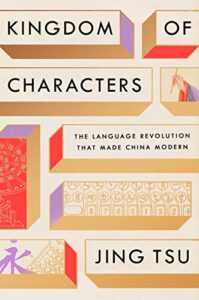Kingdom of Characters: The Language Revolution That Made China Modern by Jing Tsu. Riverhead Books, 2022, 336 pages. ISBN-10: 0735214727, ISBN-13: 978-0735214729. Available from Amazon.
In her excellent book Kingdom of Characters, Jing Tsu traces the modern development of the written Chinese language from a system of complicated hand-written characters mastered primarily by the elites of Chinese society to a broadly accessible digital format employed by Asian-language speakers around the world. More than just a fascinating historical tale of linguistic and technological innovation—which it certainly is—Tsu’s book is an exploration of the role language has played in China’s nation-defining pursuit of modernization.
“A language is a dialect with an army and navy.”
This quote from Yiddish linguist Max Weinreich, found at the very end of Kingdom of Characters (p. 279), neatly summarizes the book’s larger story: language can be a tool that expands national power. By highlighting the places where the development of China’s language has intersected with the nation’s political development, Tsu makes it clear that China’s rise from feudal dynastic empire to modern global superpower owes much of its pace and breadth to the work of many individuals inside and outside of China who contributed to the evolution of China’s written language. In this way, the book’s title contains a double meaning: the story of the development of the kingdom of Chinese characters is also the story of the development of the Chinese kingdom from which these characters have come.
The book is organized in a straightforward, chronological fashion with seven chapters that move from the nineteenth century up to the present. Tsu’s account covers translation dictionaries, the vernacular movement, and romanization schemes such as pinyin, as well as technological innovations involving manual typewriters, typesetting, photographic printing, and, more recently, the digitization of the language through Unicode codification. As the timeline unfolds, official and popular attitudes towards the written language vacillate between shame (characters are too awkward, slowing China’s development) and pride (characters are China’s unique cultural heritage). In Tsu’s telling, China’s place among the nations rises in tandem with the development of her language, revealing the intimate relationship between linguistic modernization and the modernization of the nation itself.
Along the way, readers are introduced to a host of interesting characters and little-known vignettes of Chinese history. Missionaries and Bible translators receive early attention alongside Chinese officials advocating for linguistic (and national) reform. Famous Christian philosopher Lin Yutang has a surprisingly prominent role in China’s linguistic development, including his rarely-acknowledged efforts to invent and manufacture a functional Chinese-language manual typewriter in the 1940s (pp. 163–168). Another lesser-known hero, Guangzhou librarian “Bismarck Du,” not only developed a helpful way to classify and organize Chinese characters: he led a team of librarians to evacuate and preserve a collection of 300,000 irreplaceable Chinese-language volumes during the Second World War (pp. 151–163).
While the subject matter of this book may seem obscure, Tsu does an excellent job placing her details within China’s larger historical context. This makes her narrative easy to follow while also yielding many fascinating tidbits of China’s history for the general reader. For instance, Tsu explains that the Dungan people of Kyrgyzstan are actually members of the Hui, a Chinese ethnic minority—an important point for her account, since the Soviet-supported effort to alphabetize the Dungan language was a key component of the later Chinese pinyin project (p. 198). Her account of the development of the Unicode standard for recognizing Chinese characters across all digital systems is similarly intriguing, revealing how the Taiwanese delegation successfully maneuvered to have their own coding classification, based on traditional characters, enshrined in Unicode in the 1980s (p. 254–261). Since then, mainland Chinese scholars and politicians have been flexing China’s growing international influence and power to redesign Unicode to reflect their simplified character linguistic vision—a mission that ultimately has more to do with political pride than linguistic practice.
Though beyond the scope of Tsu’s study, it is important to recognize that the battle over who will shape the digital structure of Chinese characters in the future is becoming less and less important for younger Chinese. Raised on a steady diet of pirated, streamed or otherwise viewed content from across the Sinosphere, today’s Asian youth have been conditioned by all those subtitles to be comfortable with both simplified and traditional characters.1 National education systems continue to push their own linguistic agendas, but they are competing against a much larger and more engaging online world where transgression and hybridity are the fashion. It remains to be seen whether politics and regulation will be able to preserve the ideographic divisions of the past century in the face of the creative will of tomorrow’s youth. But as Tsu’s study reminds us, language and politics can never be completely separated.
Endnotes
- Liu Yuli, “ The All-Too Complicated History of Simplified Chinese” Sixth Tone, January 16, 2023. Accessed March 21, 2023, https://www.sixthtone.com/news/1012040.
Image credit: Kaori Kubota via UnSplash.
Andrew T. Kaiser
Andrew T. Kaiser, author of Voices from the Past: Historical Reflections on Christian Missions in China, The Rushing on of the Purposes of God: Christian Missions in Shanxi since 1876, and Encountering China: The Evolution of Timothy Richard’s Missionary Thought (1870–1891) has been living and working in Shanxi with his …View Full Bio
Are you enjoying a cup of good coffee or fragrant tea while reading the latest ChinaSource post? Consider donating the cost of that “cuppa” to support our content so we can continue to serve you with the latest on Christianity in China.
